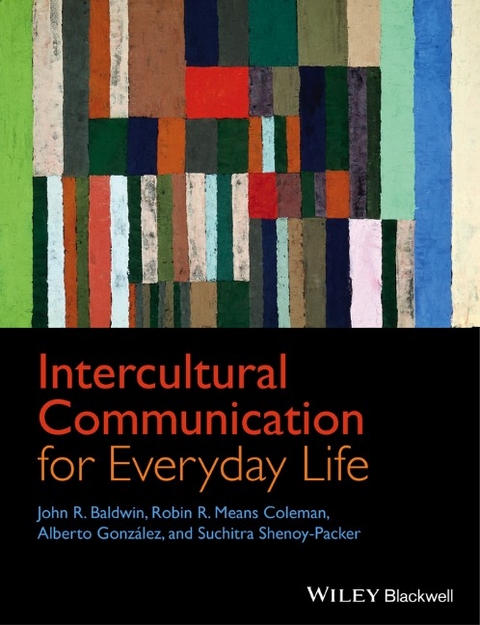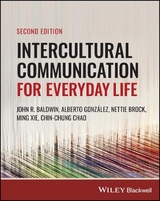
Intercultural Communication for Everyday Life
Wiley-Blackwell (Verlag)
978-1-4443-3236-0 (ISBN)
- Titel erscheint in neuer Auflage
- Artikel merken
Provides a thorough introduction to inter- and cross-cultural concepts for beginning students with a focus on practical application and social action
Defines “communication” broadly using authors from a variety of sub disciplines and incorporating scientific, humanistic, and critical theory
Constructs a complex version of culture using examples from around the world that represent a variety of differences, including age, sex, race, religion, and sexual orientation
Promotes civic engagement with cues toward individual intercultural effectiveness and giving back to the community in socially relevant ways
Weaves pedagogy throughout the text with student-centered examples, text boxes, applications, critical thinking questions, a glossary of key terms, and online resources for students and instructors
Online resources for students and instructors available upon publication at www.wiley.com/go/baldwin
John R. Baldwin is Professor of Communication at Illinois State University. Robin R. Means Coleman is Associate Professor in the Departments of Communication Studies and Afroamerican and African Studies at the University of Michigan. Alberto González is Professor of Communication at Bowling Green State University. Suchitra Shenoy-Packer is Assistant Professor of Communication Studies at DePaul University.
Preface xi
Acknowledgements xv
About the website xvi
Walk through xvii
Part One Foundations 1
1 A rationale for studying intercultural communication: Why should we know about other cultures? 3
Building a rationale: Why do we need to know about intercultural communication? 5
The personal growth motive 5
The social responsibility motive 6
The economic motive 8
The cross-cultural travel motive 10
The media motive 13
Challenges of studying intercultural communication 15
The history and focus of intercultural communication: Where did we come from? 16
Summary 19
Key terms 19
Discussion questions 20
Action points 20
For more information 20
2 Action, ethics, and research: How can I make a difference? 24
Muslim veils in French schools: How can we determine right from wrong in intercultural situations? 26
Ethics and morality 27
Determining a universal ethical stance 28
Ethical relativism 29
“ Not in our town:” What is the role of intercultural communication in civic engagement? 30
Political and civic engagement 31
Defending civic and political engagement among college students 32
Doing civic engagement 34
How can we do responsible cultural research? 35
Assumptions that guide cultural research 36
Approaches to studying culture and communication 36
Differences of focus in culture-and communication studies 41
Summary 42
Key terms 43
Discussion questions 43
Action points 44
For more information 44
3 Origins: Where does our “culture” come from? 47
The relationship between communication and culture: How do they inform each other? 49
Defining communication 49
The relationship between communication and culture 51
Defining culture: How can we define culture—and what are the implications of our definition? 52
Aspects and elements of culture: What is culture like? 55
Aspects of culture 55
Characteristics of culture 56
A model of interaction: How can we best understand intercultural and intergroup communication? 61
Summary 63
Key terms 64
Discussion questions 64
Action points 65
For more information 65
Part Two Elements 69
4 Subjective culture: What is the base upon which cultural communication is built? 71
Basic building blocks of culture: What are the most important things to know? 72
Cultural values: What are some useful frameworks for understanding culture? 75
High- and low-context cultures 76
Hofstede’s cultural dimensions 77
Culture-specific (emic) approaches 81
World view: What are the beliefs at the center of our “world”? 84
Summary 87
Key terms 87
Discussion questions 88
Action points 88
For more information 89
5 Identity: Struggle, resistance, and solidarity: How can I think about my identity and that of others? 91
An introduction to identity: Who am I, really? 92
Identity and communication: How do we communicate our identities? 95
Social identity theory and stages of identity development 95
Identity is created through communication 95
You are what you eat: Food as an example of identity 96
Identity and politics: How can our identities be political? 97
Identity politics 98
Punk rock and identity politics: A case study in brief 98
Ideology, the KKK, and subtle White power 100
Hegemony: National-regional and sexual orientation power plays 102
Identity in intercultural communication: What are some problematic ways to think about the identities of other groups? 103
Orientalism 103
The symbolic annihilation of race 105
Identity, solidarity, and civic action: Can I make a difference? 108
Summary 109
Key terms 110
Discussion questions 110
Action points 111
For more information 111
6 Intolerance–acceptance–appreciation: How can we make the world a more tolerant place? 114
Framing the problem: Where can we recognize intolerance? 116
Terms: What are some different types of intolerance? 116
Debates: Where does racism lie, and who can be racist? 123
Looking to a better future: What are some causes of and solutions for intolerance? 126
Understanding the problem: Possible causes of intolerance 126
Addressing the problem: Possible solutions to intolerance 128
Summary 130
Key terms 131
Discussion questions 132
Action points 132
For more information 132
Part Three Messages 135
7 Verbal communication: How can I reduce cultural misunderstandings in my verbal communication? 137
Systems of language and culture: Why is talking across cultures so difficult? 138
Systems of meaning 139
Speech acts and cultural communication 141
Getting things done with language 141
Explaining the details: Seeking ways to explain differences across cultures 143
Discursive elements of cultures: What happens when we join the elements of language? 147
Cultural myth 147
Conversational episodes 148
Social dramas 149
Cultural metaphor 150
Theories of conversation and culture: What happens when we actually talk to each other? 151
Communication accommodation theory 152
Communication and sites of dominance 153
Summary 154
Key terms 154
Discussion questions 155
Action points 155
For more information 156
8 Nonverbal communication: Can I make nonverbal blunders and not even know it? 159
Forms and functions: How should we act nonverbally when in another culture? 161
Channels (forms) of nonverbal communication 162
Functions of nonverbal communication and relations to verbal communication 164
Issues in nonverbal communication: How can I compare several cultures at the same time? 166
Issue number 1: I can understand your facial expression—but does it mean what I think it means? 166
Issue number 2: Why are you standing so close to me? Space and other aspects of contact 167
Issue number 3: Does anybody really know what time it is? 169
Issue number 4: Why are you being so quiet? Cultural understandings of silence 170
Nonverbal expectancy violations: What does your nonverbal behavior mean? 171
Culture and the expectancy violations model 172
Culture and meaning: Semiotics 173
Summary 175
Key terms 176
Discussion questions 176
Action points 177
For more information 177
9 Rhetoric and culture: How does my culture relate to persuasive writing and speaking? 180
Rhetorical communication: How does culture inform persuasion? 181
Rhetorical traditions: How do people in different cultures try to persuade? 182
African American tradition: Rooted in resistance 184
Chinese tradition: Rooted in social reflection 185
Latino/a tradition: Rooted in revolution 187
Native American tradition: Rooted in nature 189
Western tradition: Rooted in argument 191
Limitations when considering rhetorical traditions 192
Vernacular rhetoric: How does everyday communication seek to persuade? 193
Vernacular rhetoric in Africa 193
Vernacular rhetoric in South Toledo, Ohio 195
Intercultural rhetoric: What are the implications for civic engagement? 197
Summary 199
Key terms 199
Discussion questions 200
Action points 200
For more information 200
10 Culture, communication, and media: How do media shape our views of others? 203
Effects and rituals: What role do media play in our lives? 204
Lasswell’s model of (mediated) communication 204
The transmission view versus the ritual view 205
The role of media in intercultural communication 206
Democratic discourse and diversity: What issues do media present to me as a citizen? 207
Media and cultural identities: Who are “we” now? 210
Digital media and social movements 210
Gender media frames: The social acceptability of showing breasts 212
Representational absences as an impediment to intercultural communication 217
Beyond traditional media: How do new media and culture shape each other? 218
Summary 220
Key terms 221
Discussion questions 221
Action points 221
For more information 222
Part Four Contexts 225
11 Global media, global cultures: How do culture and globalization influence each other? 227
Culture on the global media stage: How does the global flow of information impact culture? 230
The global media experience 232
Satellite television: The progenitor of global media 234
Instantaneous cultural exchange: When time becomes timeless 236
The inequality of global media flow 237
Power and globalization: What drives the global media? 239
Global media from above and below: Hip hop 240
The challenges of global media flows 242
Summary 245
Key terms 246
Discussion questions 246
Action points 246
For more information 247
12 Adaptation and intercultural competence: How can I be effective in a new culture? 249
Cross-cultural adaptation: How can I better adjust to a new culture? 250
Adjustment and culture shock: Defining the terms 251
Models of cultural adjustment 251
Rethinking acculturation: What happens when cultural groups live side by side? 256
Coming home: Will it be as easy as it sounds? 258
The process and nature of return cultural adjustment 258
Making the going and coming home easier 261
Intercultural communication competence: How can I get the job done… and still be liked? 262
Understanding intercultural competence 262
Beyond the multicultural person: Intergroup effectiveness 264
Summary 265
Key terms 265
Discussion questions 266
Action points 266
For more information 267
13 Relationships and conflict: How can I have better cross-cultural relationships? 269
Culture and communication in relationship: How do intercultural relationships grow and thrive? 271
What partners bring with them into relationships 271
How do intercultural relationships work? 274
Unique cultural relationship patterns 276
Societal power and intercultural and intergroup relationships 279
Relational and organizational conflict: How can I make intercultural conflict more productive? 280
Cross-cultural approaches to conflict resolution 280
International negotiation 283
Summary 285
Key terms 286
Discussion questions 286
Action points 287
For more information 287
14 The political context: How can we use communication to shape politics and culture? 290
Politics, culture, and communication: How do politics relate to culture? 292
Making change happen: What are some examples of successful social movements? 294
The Green Belt Movement 294
The immigrant rights movement 296
Intercultural political leadership: What strategies can we use to bring about change? 298
Majora Carter and the Bronx River Alliance 298
Servant leadership and TOMS shoes 300
Summary 302
Key terms 303
Discussion questions 303
Action points 303
For more information 304
15 Intercultural communication in international organizational contexts: How does culture shape business, and how is business culture changing? 306
A new contract: How are technology and information changing the culture of work and workplaces? 308
New workers, new contracts 308
Globalization and corporate and local cultures 309
Cultural variability: How does culture shape the organization? 312
Trompenaars and Hampden-Turner’s cultural orientations 312
Orientation toward time 316
A new world: What are the impact of globalization on business? 317
Convergent and divergent hypotheses of business in a globalizing world 318
Types of organization 319
National/corporate cultures 321
Corporate responsibility: How can my company make a difference? 322
Case studies of corporate social responsibility 322
Intercultural organizing and communication for civic engagement 323
Summary 325
Key terms 325
Discussion questions 326
Action points 326
For more information 327
Conclusion 329
Glossary 331
Index 343
| Erscheint lt. Verlag | 31.1.2014 |
|---|---|
| Verlagsort | Hoboken |
| Sprache | englisch |
| Maße | 188 x 246 mm |
| Gewicht | 748 g |
| Themenwelt | Sozialwissenschaften ► Kommunikation / Medien ► Kommunikationswissenschaft |
| ISBN-10 | 1-4443-3236-8 / 1444332368 |
| ISBN-13 | 978-1-4443-3236-0 / 9781444332360 |
| Zustand | Neuware |
| Informationen gemäß Produktsicherheitsverordnung (GPSR) | |
| Haben Sie eine Frage zum Produkt? |
aus dem Bereich



